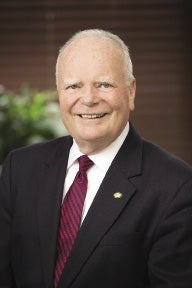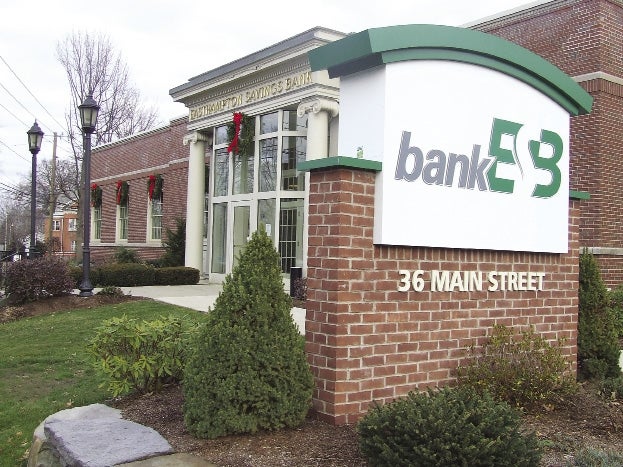Banks combining power, keeping identities
Community banks -- striving to compete against multi-billion conglomerates while maintaining their strong local ties -- are taking a creative approach to combine their power while retaining their identities.
By merging holding companies as opposed to the banks, the organizations are able to retain their name and management while getting much of the cost-savings and the size associated with a traditional merger. The technique moves much of the work that is done during a traditional merger to the holding company level, where finances and oversight of the two holding companies come together, but community banks retain their same front-facing relationship to customers.
“Ultimately this is about two banks getting together to form a partnership so that the sum can be more than our parts,” said Matthew Sosik, Easthampton Savings Bank president and CEO. “Size has really taken a priority in the world of banking, not because bigger is better, but scale is critical with the cost pressures community banking is facing … scale has become critical to the longer-term view.”
This has been instituted in October by SpencerBANK and Southbridge Savings Bank. The combined mutual holding company will have close to $1 billion in assets and $108 million in equity and represent a branch network of 15 offices located throughout Central Massachusetts. Despite this, the banks will remain separate entities.
Merging holding companies will expand bank deposits and lending abilities, thus making both banks more competitive, said Todd Tallman, president and CEO of Southbridge Savings Bank.
Hometown Bank and Easthampton Savings Bank also undertook a merger of their holding companies in September. The merger of ESB Bancorp Inc. with Hometown Community Bancorp will create a mutual holding company with more than $1.7 billion in assets, more than $180 million in equity capital, and a combined branch network of 23 offices in Central and Western Massachusetts and Northeast Connecticut. This will place the new holding company among the top 10 largest banks in Central Massachusetts when ranked by assets.
To the customer, there will be no transition, Sosik said. This is especially true because there was no geographic overlap between the banks, leaving no branches to be shut down.
There are numerous benefits from merging these holding companies, including the bank's lending power, said Michael Hewitt, Hometown Bank president and CEO. Hometown Bank, for example, had a legal lending limit of $9 million. Once the holding company merger is completed early next year, the bank can loan a customer up to $35 million.
Hewitt sees this model as a potential boon for other industries as well.
“I can see companies finding ways to streamline and save costs and keep their identity and deliver better services for their customers and employees,” he said.
The benefits also extend to eliminating redundancies and reducing the expense of essential back office duties such as government reporting. Before the holding company merger, Hometown Bank was preparing to create a call center and dedicated technology center. Now, it can make use of those that Easthampton already has in place while retaining the services customers have become accustomed to.
“I can compete so well and so easily against (national banks) in some ways because you can call me on my cell phone on a Sunday afternoon,” Hewitt said. “Try to do that with any of the large banks.”
There are drawbacks to merging holding companies rather than undertaking a traditional merger. Fidelity Bank President and CEO Ed Manzi Jr. explored merging holding companies before pursuing a traditional merger with Barry Savings Bank.
The type of merger has to make sense for the situation, he said. Fidelity's establishment of a $1.5-million community foundation for the Barre, Paxton, and Princeton area because its traditional merger allowed the resulting entity to set aside more money for the community than if a non-traditional merger had been pursued.
“It's very deal specific. You have to take this lens of structure-follows-strategy and what works best for the community and bank and come up with a specific answer for those sets of facts,” Manzi said.
There is also the question of efficiency. While there are certainly more efficiencies by having two banks sharing resources under a joint holding company, there are still inherently some redundancies, said Sosik. This is a part of the tradeoff of retaining the franchise value of the individual bank names and customer relations.
“It is an imperfect method if you are looking to extract all the efficiencies. It is a perfect method if you are looking to preserve the legacy and effectiveness of the traditional brands,” Sosik said.
There are also additional nuances that must be worked out with a holding company merger that do not occur to the same degree as a traditional merger, such as the name of the holding company, the makeup of the board, safeguards against a bank takeover. These talks as having the potential to be very, very sticky, Sosik said.
Once all those details are worked out, it puts the overarching holding company in a position ready to add more banks, he said.
This is an opportunity for the banks already under the holding company, who could have access to even more assets as additional banks are added, but also for banks who have another option rather than being completely absorbed in a traditional merger, Sosik said.
Moving forward, all three bank presidents foresaw additional mergers in the current tough banking environment.
Whether they will be traditional mergers or a joing of holding companies will depend very much on each situation.
“The whispers and the chatter in our industry seem to indicate a lot of talk among banks about mergers or mutual holding companies,” Sosik said.
















0 Comments